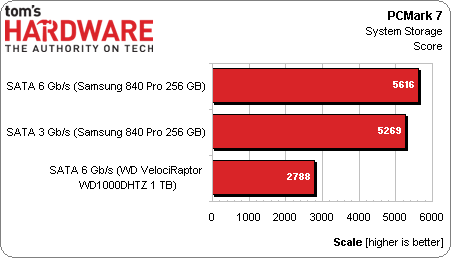Is A SATA 3Gb/s Platform Still Worth Upgrading With An SSD?
Today's fastest SSDs already bounce off the SATA 6Gb/s interface's throughput ceiling. Does a 3 Gb/s link kill the performance of those drives? We run a number of synthetic and real-world tests to assess the damage when you upgrade an older platform.
Results: PCMark 7 And Trace
The 840 Pro’s performance is a bit higher attached to the 6 Gb/s port compared to the 3 Gb/s connection under PCMark 7, though the difference is small.
The overview shows that loading applications and importing pictures in Windows Photo Gallery happens faster over a SATA 6Gb/s port than a 3 Gb/s connection. Of course, even then, the throughput-constrained SSD is still way faster than a hard drive.
Our gaming trade only favors the 6 Gb/s port by a bit.
Get Tom's Hardware's best news and in-depth reviews, straight to your inbox.
Current page: Results: PCMark 7 And Trace
Prev Page Results: I/O Benchmark Profiles Next Page Results: PCMark Vantage-
Combat Wombat Far Out! I didnt realise there was such a big difference between my Raptor, and a Samsung's 840,Reply
Thanks toms, Samsung will get a few hundred out of me next pay day. :P -
nukemaster I have been using an M4(on SATA 3gigabit/sec) on my older media center as a boot drive and for some games. The difference from the hard drive it replaced was massive. The old hard drive is still great for storing media and files.Reply -
DarkSable This... was a kind of stupid test. Of COURSE an SSD is a good thing even on a SATA II connection.Reply
Does Tom's not remember the early days of SSDs, when everyone wanted one and noone could afford one? There was no such thing as SATA III back then, and if SSDs didn't give a benefit, nobody would have payed attention with how expensive they were. -
LordConrad ReplyEven With SATA 3Gb/s, An SSD Makes Sense
I could've told you that. I put a OCZ Vertex 2 in my HP dv6t-2100 laptop a while ago and the difference was like night and day. SATA II is definitely SSD worthy! -
Onus This article measured what was intuitively obvious. My primary system's boot drive is a 3Gb/s mSATA Crucial M4; I've felt no need to upgrade. Just today I put a 128GB 6 Gb/s SSD on an old 790GX board, and the difference is amazing.Reply
-
rdc85 IMO It well worth it, if u had the budget... (even it in sata2 mode)Reply
still the price is the issue...
hope the price will continue to decline, so it became affordable for (most of) everyone.... -
jimmysmitty Combat WombatFar Out! I didnt realise there was such a big difference between my Raptor, and a Samsung's 840,Thanks toms, Samsung will get a few hundred out of me next pay day.Reply
Any SSD on 3Gb/s kill Raptors outright. Even my older X25-M does due to the sheer IOPS compared to a Raptor or any mechanical HDD.
I do need to upgrade but not for the speed, mostly for size. 80GB is not enough even for OS and a few apps. I have messed with everything from a SATA II SSD to a PCIe SSD (Revo 3) and as long as you are on SATA II or better its going to be more than fast enough.
But that said, I might just wait for Broadwell and SATA Express. -
mayankleoboy1 1. This test feels kind of incomplete. What i felt was the right comparison was to add a native SATA2 SSD on a SATA2 port, and then compare it to a SATA3 drive on a SATA2 port.Reply
2. The startup and shutdown times will increase once you start adding softwares to the system. Specially, an Antivirus (kaspersky internet security) makes me weep on startup on a mechanical disc.
3. Kind of stupid question : Will overclocking the CPU improve the startup/shutdown times, now that the storage bottleneck is largely removed ?
4. Can we have the time taken by each system to install all the Windows updates, just after the fresh install ? -
coolbz DarkSableThis... was a kind of stupid test. Of COURSE an SSD is a good thing even on a SATA II connection.Does Tom's not remember the early days of SSDs, when everyone wanted one and noone could afford one? There was no such thing as SATA III back then, and if SSDs didn't give a benefit, nobody would have payed attention with how expensive they were.Reply
This article does give very important guideline, where people evaluate different upgrade options. Conclusion is, you don't need to replace a SATA2 computer with SATA3 computer for the mere of SSD speed benefit.



